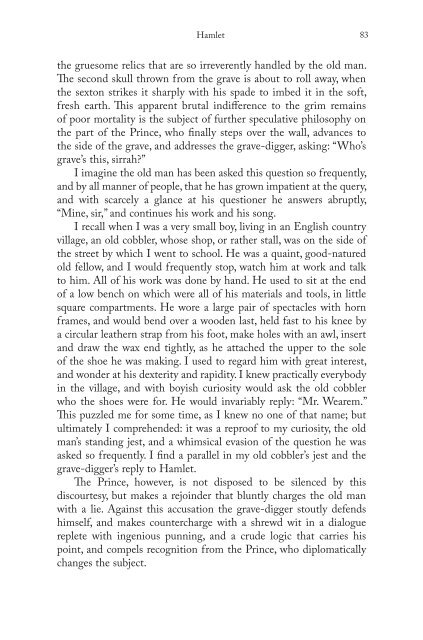Blooms Literary Themes - THE TRICKSTER.pdf - ymerleksi - home
Blooms Literary Themes - THE TRICKSTER.pdf - ymerleksi - home
Blooms Literary Themes - THE TRICKSTER.pdf - ymerleksi - home
You also want an ePaper? Increase the reach of your titles
YUMPU automatically turns print PDFs into web optimized ePapers that Google loves.
Hamlet 83<br />
the gruesome relics that are so irreverently handled by the old man.<br />
Th e second skull thrown from the grave is about to roll away, when<br />
the sexton strikes it sharply with his spade to imbed it in the soft,<br />
fresh earth. Th is apparent brutal indiff erence to the grim remains<br />
of poor mortality is the subject of further speculative philosophy on<br />
the part of the Prince, who fi nally steps over the wall, advances to<br />
the side of the grave, and addresses the grave-digger, asking: “Who’s<br />
grave’s this, sirrah?”<br />
I imagine the old man has been asked this question so frequently,<br />
and by all manner of people, that he has grown impatient at the query,<br />
and with scarcely a glance at his questioner he answers abruptly,<br />
“Mine, sir,” and continues his work and his song.<br />
I recall when I was a very small boy, living in an English country<br />
village, an old cobbler, whose shop, or rather stall, was on the side of<br />
the street by which I went to school. He was a quaint, good-natured<br />
old fellow, and I would frequently stop, watch him at work and talk<br />
to him. All of his work was done by hand. He used to sit at the end<br />
of a low bench on which were all of his materials and tools, in little<br />
square compartments. He wore a large pair of spectacles with horn<br />
frames, and would bend over a wooden last, held fast to his knee by<br />
a circular leathern strap from his foot, make holes with an awl, insert<br />
and draw the wax end tightly, as he attached the upper to the sole<br />
of the shoe he was making. I used to regard him with great interest,<br />
and wonder at his dexterity and rapidity. I knew practically everybody<br />
in the village, and with boyish curiosity would ask the old cobbler<br />
who the shoes were for. He would invariably reply: “Mr. Wearem.”<br />
Th is puzzled me for some time, as I knew no one of that name; but<br />
ultimately I comprehended: it was a reproof to my curiosity, the old<br />
man’s standing jest, and a whimsical evasion of the question he was<br />
asked so frequently. I fi nd a parallel in my old cobbler’s jest and the<br />
grave-digger’s reply to Hamlet.<br />
Th e Prince, however, is not disposed to be silenced by this<br />
discourtesy, but makes a rejoinder that bluntly charges the old man<br />
with a lie. Against this accusation the grave-digger stoutly defends<br />
himself, and makes countercharge with a shrewd wit in a dialogue<br />
replete with ingenious punning, and a crude logic that carries his<br />
point, and compels recognition from the Prince, who diplomatically<br />
changes the subject.

















